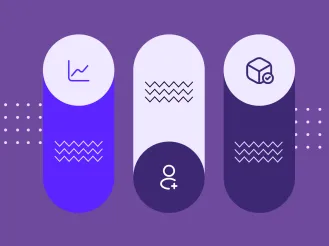Optimize Your Higher Ed Website to Move Prospective Students Through the Decision Funnel
Prospective students don’t just make one decision about where to attend college or university. They make countless micro-decisions all along the way. Is this school worth my time to look at? Does it look like somewhere I’d fit in? Do they have the academic or adult learning programs I’m interested in? Should I visit campus in person or just do a virtual tour? What’s student life like? How will I afford it?
The decisions prospective students make in response to these questions will either lead them toward or away from the all-important “Apply Now” button. Therefore, you need to design a website that helps them navigate each micro-decision until it’s time for them to make their ultimate decision: whether or not to attend your institution.
To make your website the decision-inspiring tool it can be, start by establishing a baseline of how users navigate and interact with your site now. Then optimize your site based on what you discover. Here’s how.
Evaluate Your Current Website’s Performance
Taking a thorough look at how your website performs today will help you identify opportunities for improvement and optimization. Don’t start making changes until you really understand what’s working and what’s not working.
Specifically, you need to know which of your goals and performance metrics are being met. How many inquiries do you receive? How many applications are submitted in a given month? Are there micro goals you want to track, like seeing a student complete a virtual tour or use a cost calculator?
You’ll likely discover a number of easy fixes along with higher-effort changes you’ll need to make. To help you prioritize, dig into your data analytics, and map out your user journeys.
Dig Into the Data
There’s no shortage of available data to measure your website’s performance. You should be able to track answers to the following questions:
- How much traffic does your website get in a year?
- Where is your traffic coming from? I.e. How many visitors arrive on your site via organic search versus clicking on an ad?
- Are there seasonal ups and downs that affect your traffic patterns?
- What keywords and search phrases are used most often?
- Which pages do users view, and how many pages do they look at per session?
- How long do visitors spend on your site?
- What types of content attract the most interest?
- When do users bounce or exit your site?
If you haven’t been tracking this information, it’s time to start. Do so in one or all of the following ways:
- Set up Google Analytics. Establish specific goals and interactions you want to observe (e.g. for users who visit the contact page, how many pages do they view first?)
- Create a heatmap to see a color-coded visual representation of which parts of your site are clicked on most (and which are ignored).
- Develop quick Hotjar user polls to ask for insight into the kinds of content users find helpful. These can be triggered based on specific behaviours.
Wait for some of that data to come in before you make any changes at all. Then, begin tweaking and testing to see what drives better results. For example, you may find that keyword searches aren’t giving users the search results they’re looking for. In that case, optimize your site by adding the keywords users are actually using into the metadata or by sprinkling them throughout the content in key pages. That will help Google crawl your site more effectively and serve users in the process.
Or, if you observe a large number of drop-offs when users access a certain form, take a look at that form. Does it require too much information? Is it too long? Try simplifying it and see if your drop-off rate improves as a result.

Map Out User Journeys
To understand your personas and their user journeys — and ultimately make changes to encourage the user behavior you want to see — look at the following:
- How do potential students (or their parents) arrive at your site? How many come via organic search versus paid media?
- Do organic searchers engage with the site differently than those arriving via paid media?
- Which pages do visitors view and in what order?
- Do prospective students take the next steps you desire, like signing up for a tour or reaching out to an Admissions Counselor?
- What does the user journey look like for students who do apply? How do they navigate your site, and what do they interact with prior to making the decision to move forward?
Once you understand what current users are doing, think through what you want them to do. How can you personalize their experience as much as possible to keep them engaged and spark their interest? How can you make changes that will get them to take the next steps that will move them through the decision funnel?
Here’s a common example of what examining your user journeys might reveal. Perhaps you see that prospective students are clicking around to discover what your school offers. They look interested. But once they start visiting pages that talk about cost, they drop off rather than requesting more information or applying.
Think through why that might be happening. Visit those pages. Is the information clear? Can students easily determine their real all-in cost? Is there a cost calculator to help them factor in standard financial aid packages based on their GPA or SAT scores? If your cost is buried or totally unfindable, fix that. Students don’t want to waste their time applying for admission if there’s no way they can afford it.

Improve Site Navigation and Findability
Once you’ve evaluated the hard data and understand how your website is performing, make design changes to improve your site’s ability to drive conversions. You can’t put everything on your home page (in fact, please don’t make this common mistake). But you do need to invite users to explore and discover what your site has to offer.
There are two ways that users typically interact with a website. You need to design for both types.
- Explorers. This type of visitor wants to take it all in and really get a feel for your school. They will click on whatever grabs their attention and see where the experience serendipitously leads them. Therefore, it’s important to make your website a hub for student-focused content that draws these users in and tells them a compelling story.
- Searchers. These folks know what they’re looking for and want to self-serve to find answers to their questions. They might already know a specific major or extracurricular activity is a must-have, so they’re creating their shortlist based on that criteria. To best serve these users, make sure your search functionality is top-notch, and make smart use of keywords and common search phrases.
After you’ve made changes, compare new data to your baseline to see what’s working and what still needs to be enhanced.
Make Your Website a Powerful Admissions Tool
In an increasingly competitive higher education landscape, every tool in your Admissions team’s marketing toolbox needs to be sharpened for success. And the most important tool of all is your website. After all, most of your prospective students live online. They make friends online, spend countless hours on their devices, and have never functioned in a world without Google. So when it’s time to research colleges and universities, they expect to find answers to their questions on your website.
Dig into your data. Evaluate your user journeys. Really understand how your website is performing today, and then make changes that will invite prospective students to discover everything that’s unique and wonderful about your institution. Doing so will move them through the decision funnel and help them get one step closer to reaching their educational goals.



